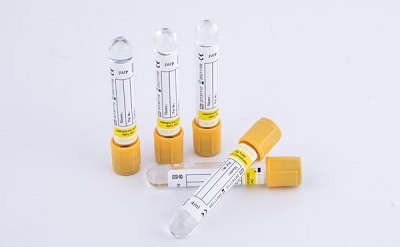Introduction of serum collection tubes
1. Generally, the blood cell tube has a bright red cap, and there is no preservative in the blood collection tube. It is used for basic blood cell biochemistry, blood bank and serology related tests.
2. The orange-red cap of the rapid blood cell tube, and the blood collection tube contains a coagulant, which can stimulate the chemical fiber trypsin, so that the soluble free fatty acid becomes an insoluble free fatty acid polymer, thereby producing a smooth free fatty acid consistency. The rapid blood cell tube can coagulate the collected blood within 5 minutes, and is suitable for outpatient blood cell generalization experiments.
3. Inert separation gel and coagulation accelerator tube with golden yellow head cover, and inert separation gel and coagulant are added in the blood collection tube. After the specimen is collected and filtered, the inert separation gel can completely separate the liquid components (blood cells or blood) and solid components (blood cells, white blood cell count, platelets, free fatty acids, etc.) in the blood and completely stack them in the center of the IVF to create a natural barrier. , The specimen collection is maintained for a long time within 48 hours. The coagulant can quickly stimulate the blood coagulation function and accelerate the coagulation process, suitable for outpatient blood cell biochemistry experiments.
4. Heparin anticoagulant tube has emerald green head cap, and heparin is added to the blood collection tube. Heparin immediately has the effect of antithrombin, which can prolong the clotting time of specimen collection. It is suitable for blood cell ductility test, blood gas analysis, hematocrit test, erythrocyte sedimentation rate and general energy biochemical measurement. It is not suitable for blood coagulation test. Too much heparin will cause the accumulation of white blood cell count and cannot be used for white blood cell count. It can make the blood slice look light blue after coloring, so it is not suitable for white blood cell classification.

5. The blood separation tube has a light green head cover. Add lithium heparin anticoagulant to the inert separation rubber hose to achieve the purpose of quickly separating blood. It is the best choice for electrolyte solution testing, and can also be used for basic Blood biochemistry measurement and outpatient blood biochemistry test such as ICU. The blood sample collection can be operated immediately on the machine and maintained stable for 48 hours under freezing conditions.
6. EDTA anticoagulation tube blue-purple head cap, ethylenediaminetetraacetic acid (EDTA, relative molecular mass 292) and salt are a kind of hydroxypolycarboxylic acid, which can reasonably chelate sodium ions in blood specimen collection, chelate calcium or Remove the calcium reflection domain to hinder and stop the endogenous or exogenous coagulation process, thereby avoiding coagulation of blood specimen collection. It is suitable for general hematology tests. Discomfort is used for coagulation function test and platelet function test. Discomfort is also used for sodium ion, calcium ion, potassium ion, ferrous ion, alkaline phosphatase, creatine kinase and leucine hydroxy peptide Enzyme measurement and PCR experiment.
7. Sodium citrate blood coagulation function test tube light blue cap. Sodium citrate is mainly based on chelating with sodium ions in the blood to have anticoagulant effect. Applicable to the coagulation function test, the anticoagulant concentration value strongly recommended by the National Association of Clinical Laboratory Standardization (NCCLS) is 3.2% or 3.8% (equivalent to 0.109mol/L or 0.129mol/L). The ratio is 1:9.
8. The sodium citrate erythrocyte sedimentation rate test tube has a gray-black head cover. The sodium citrate concentration value specified in the erythrocyte sedimentation rate test is 3.2% (equivalent to 0.109mol/L), the ratio of anticoagulant to blood is 1:4.
Post time: Dec-13-2021





